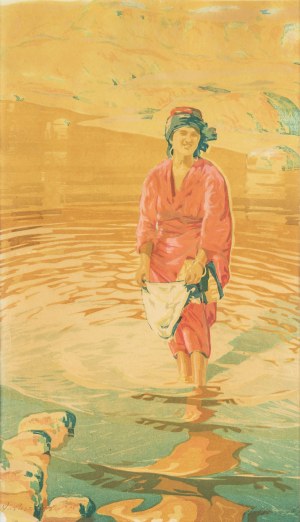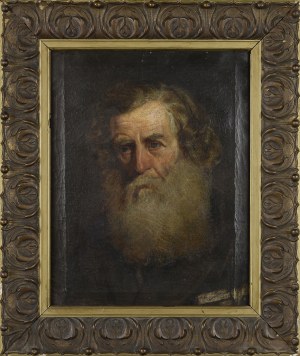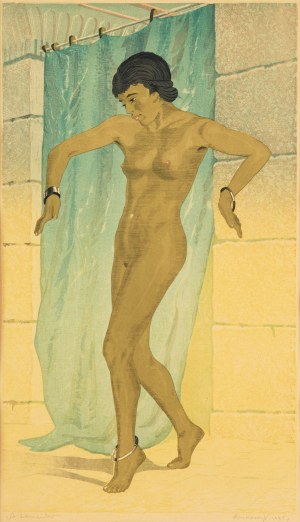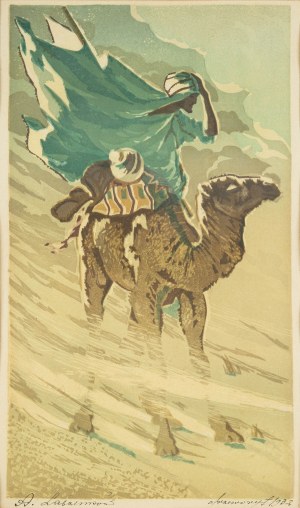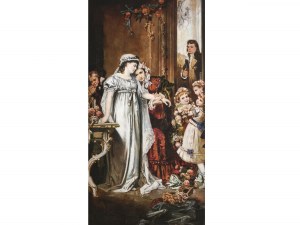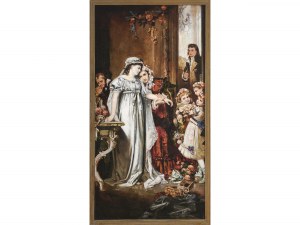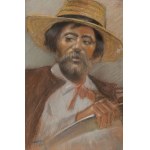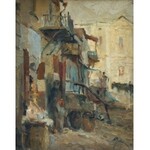oil, canvas, 197 × 398 cm
Signed, dated and described p. d.: "Al. Jakim/1936 Warsaw"
Exhibited:
- Society for the Encouragement of Fine Arts, Salon 1936, Warsaw, December 1936
Reproduced, described, mentioned:
- "Society for the Encouragement of Fine Arts in Warsaw: Salon 1936", Warsaw 1936, no. 118 (December) item 60, reproduction p. 68.
- "Report of the Committee of the Society for the Encouragement of Fine Arts for the year 1936," Warsaw 1937, p. 39.
"Who could best feel the distinct beauty and character of this people, if not the painters?"
Tadeusz Boy-Żeleński in: "Plot of Wyspiański's Wedding," Warsaw 1922, nlb.
Motifs of the countryside and rural rituals have inspired many artists in their work for years. And it was this motif that shaped the current of Polish painting from the turn of the 20th century. The richness of folk customs, related beliefs, rituals, and finally colorful costumes had been gaining popularity among painters for years. "Its [the countryside's] salient features were expressed in color and in the artistic word, its charm was melted into the most subtle human material, into a spiderweb of musical expression. And it always entices and tempts equally the charm of its bizarre beauty. Creators of every generation invariably lean on this eternally active source of inspiration, where, in its unbroken primordiality, nature and man seem to melt into one, where the boundary between human and divine is almost blurred. More primordial than many others is our village. It is also artistically more perfect. Even what the hand of man deliberately creates in it seems to flow from the great background of nature, as its necessary complement, as something indispensable that cannot be lacking in the general harmony into which all factors of being are unconsciously arranged. Nothing here is opposed to nature - everything is associated with it: both the general silhouette of the countryside, which is firmly and as if lovingly attached to the earth, and every cottage fused with it in a kind of clinging embrace, seeming to drink its vital juices from its depths, like a plant, and man, as colorful and singing as the whispers of the wind which wanders through the tree-tops are singing, and as colorful as a meadow when it is covered with a wealth of May flowers." (Album of Polish and Foreign Art - Polish Countryside, Warsaw 1910, p. 1). The compositions of, among others, Tetmajer, Wodzinowski, Radziejowski, Stasiak, Żelechowski - the so-called "five peasant painters" - departed in the manner of narration and painting from the beaten path of historical painting of the Matejko school. The glorification of simple village life resounds in their paintings. The artists clothed folk customs in colorful subjects, even small ones, where scenes related to fun, joy exploded on their canvases with color, expression, liveliness. Not surprisingly, other artists also followed in their footsteps, and Bronowice, near Krakow, became a prominent symbol of the Polish countryside. And it was these scenes that increasingly featured on the walls of TZSP or TPSP exhibitions. Artists in various conventions depicted scenes of weddings, processions, work in the fields, portraits of colorfully dressed peasant women, or simply landscapes with fields stretching all the way to the horizon. The most common scenes of work in the field are harvest, golden fields bathed in sunlight with grain, punctuated in places by the figure of a peasant woman in a vividly colored or shawl.
The painting "Harvest Festival", presented in the auction catalog, combines all the elements extolling the beauty and richness of the subject that was the countryside in painting. Here Yakimchuk depicts a harvest festival scene - the completion of the harvest and the associated revelry. This monumental multifaceted composition impresses with the grandeur of the representation. Yakimchuk appears here as a seasoned observer. Each scene depicted can be transferred into a smaller picture, telling a separate story. What delights are the details in which Yakimchuk renders each individual character in the painting, focusing on rendering the colors of costumes, poses, or facial expressions. In addition, with great painterly sensitivity, he pays attention to the second plane of the composition, where we see a lively dance.
"In our Borderlands in Volhynia, Alexander Yakimchuk was born. This is the land where, as if on a switchboard, all currents from the West and East converge. It is the land of Slowacki and the deepest Polish Romanticism, the land of Platonic ideology as opposed to Aristotelian realism, the land of the convergence of the Eastern and Latin rites, the land of exuberant imagination scampering with the winds over the immeasurable plains crisscrossed by ravines and bloated hills, the land of boundless self-sacrifice and the most brutal selfishness. This strong tension of these two poles - East and West - manifests and must manifest itself in the artist's work no matter what intensity his technique shows. This is also the case in Alexander Yakimchuk's painting, but, as far as I can see, there is a natural division of influences in his work. His oil painting is based on a range of warm, golden tones - a range emerging from Eastern spirituality. This gamut can be found in Byzantine paintings and mosaics, it is used by Italian primitives, sinking the figures of the painting into a golden background, and it can also be found in Rembrandt and Persian-Indian miniatures." (Franciszek Siedlecki, "Exhibition of paintings by Alexander Yakimchuk," Salon Sztuki C. Garlinski, Warsaw 1932, pp. 3-4.)
Recently viewed
Please log in to see lots list
Favourites
Please log in to see lots list









